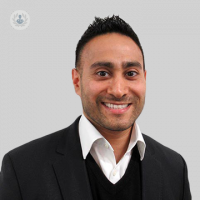Laser discectomy: An expert guide
Written by:In this informative article, highly respected consultant spinal surgeon Mr Amarjit Anand shares his expert insight on percutaneous laser disc decompression (PLDD), also known as laser discectomy, a procedure performed for some types of persistent nerve pain which does not respond to conservative treatment. The leading specialist also explains which patients are suitable for this type of procedure, as well as what to expect from the recovery period.

What is laser discectomy?
Laser discectomy (PLDD) is a procedure that can be performed for small, contained disc prolapses in the lumbar spine causing persistent low back and nerve pain (radiculopathy) radiating down the leg that fails to resolve with conservative management.
How is laser discectomy performed?
Laser discectomy is a day-case procedure that is performed percutaneously through the skin, under light sedation and using X-ray guidance.
In the procedure, a needle is inserted into the posterior aspect of the disc through the Kambin’s triangle, an anatomical corridor that allows the surgeon to access the affected disc safely. Once the needle is within the disc, a laser probe is inserted through it which allows a laser frequency to be emitted. The laser vaporises the disc prolapse, removing the associated bulge and helping to relieve low back pain and nerve pain (radicular pain) radiating down the leg.
When is laser discectomy performed?
Laser discectomy is performed when a patient is experiencing persistent pain caused by disc prolapses that have failed to settle with conservative measures, such as analgesics, physiotherapy, osteopathy and targeted lumbar injections over time.
Importantly, the configuration of the disc prolapse must be suitable for treatment by laser discectomy as the procedure is not appropriate for all types of disc injuries and disc prolapses. Suitable candidates for this procedure may have a small and contained disc prolapse which is causing persistent pain or a persistent (toxic) annular tear. A contained disc prolapse is one which is still attached to the parent disc and has not detached. Patients with a very large or central disc prolapse, an extruded or a sequestered disc prolapse would not be suitable for laser discectomy treatment.
Initially, patients with disc prolapses would undergo physiotherapy and injection therapy, allowing time to pass so that an improvement can hopefully be observed in their symptoms. Patients are considered for laser discectomy when conservative measures have not been successful and nerve pain and low back pain symptoms from the disc injury remain.
What are the associated risks and potential complications?
Complications are uncommon, but can rarely include infection. The risk of infection is very low as the procedure is performed using an aseptic technique in a theatre environment with a dose of IV antibiotics pre-operatively. Other risks could include no improvement or a recurrence of the disc prolapse. There is also a very small risk of injury to the nerve with the laser discectomy. The risk of this is smaller than with open surgery.
The procedure is performed under light sedation and without muscle relaxant. As the needle is inserted into the disc through the Kambin’s triangle, there is a chance that it may touch the nerve. Should this occur, as the patient is under sedation, the leg will move if the nerve is touched by the needle, alerting the surgeon that the needle should be recited, before laser insertion. This means that when the laser probe is ultimately inserted through the needle, it is done so safely without the risk of laser thermal injury to the nerve.
As the laser is turned on and the treatment begins, the leg is also monitored for any movement or twitching which occurs if any heat or irritation reaches the nerve. Should this happen, the laser can be stopped immediately so the nerve does not become injured. For this reason, we do not perform this procedure under general anaesthetic as the leg would not react in the same way to any irritation or contact, meaning it would only be detected after the patient has woken following surgery.
By performing the procedure under sedation, we have continual feedback and so minimise any risk of nerve injury. This surgery also avoids any scar tissue build up around the nerve root.
What is recovery time from laser discectomy like?
Patients normally take one to two days off work following laser disc surgery and then they are usually able to get back to normal activities. Following the procedure, patients may experience a low-grade ache for a few days, usually managed with simple analgesics and anti-inflammatories. On average, patients undergoing laser discectomy start noticing an improvement in their low back and nerve pain ten to fourteen days after the procedure.
If you are seeking treatment for persistent nerve pain and wish to schedule a consultation with Mr Anand, you can do so by visiting his Top Doctors profile.


